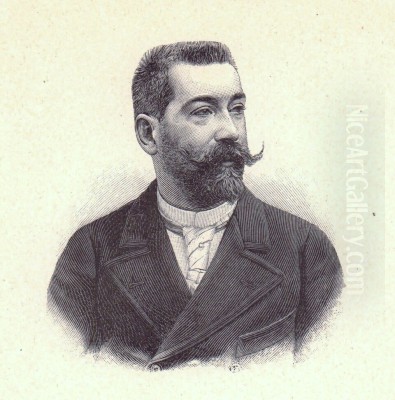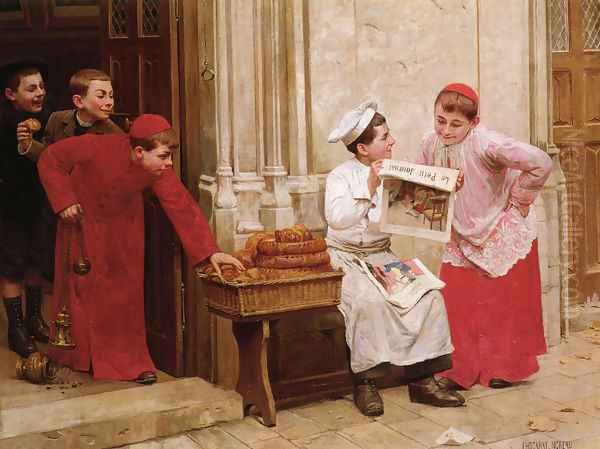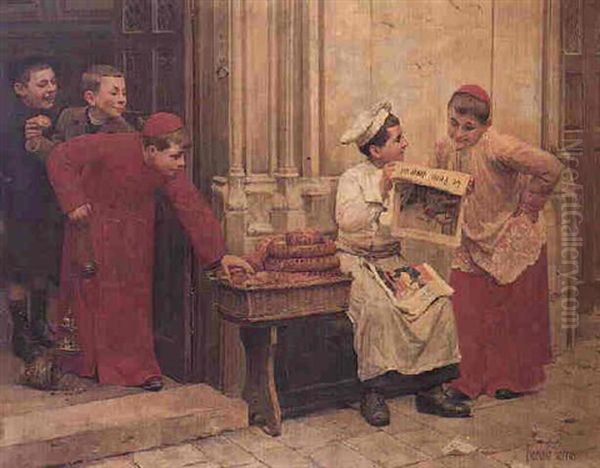
Paul-Charles Chocarne-Moreau stands as a charming and insightful chronicler of late 19th and early 20th century Parisian life, particularly noted for his affectionate and humorous depictions of childhood. Born in Dijon, in the Burgundy region of France, in 1855, he moved to Paris, the vibrant heart of the art world, to pursue his artistic ambitions. He passed away in 1931, leaving behind a body of work celebrated for its technical skill, narrative flair, and gentle social observation, securing his place among the notable French genre painters of his era.
Though perhaps overshadowed in grand art historical narratives by the revolutionary Impressionists or the established giants of Academic art, Chocarne-Moreau carved a distinct and popular niche for himself. His canvases predominantly feature children – often mischievous boys from the working classes – engaged in everyday activities, pranks, and moments of unguarded innocence. These scenes, rendered with a keen eye for detail and a warm palette, resonated deeply with the public and critics alike during his lifetime.
Formative Years and Influences
Chocarne-Moreau's artistic journey began formally in Paris, where he sought training from some of the most respected figures in the academic tradition. He enrolled at the prestigious École des Beaux-Arts, becoming a pupil of Tony Robert-Fleury. Robert-Fleury was not only a successful painter in his own right, known for his historical and genre scenes, but also a highly influential teacher whose atelier attracted numerous aspiring artists.
Further honing his skills, Chocarne-Moreau also studied under William-Adolphe Bouguereau. Bouguereau was a towering figure in the French art establishment, renowned for his meticulously finished paintings, often featuring mythological or idyllic pastoral themes, including idealized depictions of peasant children. Both Robert-Fleury and Bouguereau were masters of academic technique, emphasizing drawing, composition, and a polished finish – qualities that are evident in Chocarne-Moreau's own work, even as he applied them to less formal subjects.

The influence of these masters provided Chocarne-Moreau with a strong foundation in draftsmanship and traditional painting methods. This academic grounding allowed him to render the human figure, fabrics, and settings with convincing realism. However, he adapted these skills to suit his chosen subject matter, infusing his scenes with a liveliness and narrative charm that distinguished him from the more severe historical or mythological painters like his teacher Bouguereau or contemporaries such as Jean-Léon Gérôme.
Artistic Style and Thematic Focus
Chocarne-Moreau is primarily recognized as a genre painter, an artist specializing in scenes of everyday life. His unique contribution lies in his consistent focus on the world of children, particularly the street urchins or working boys of Paris – known colloquially as "gamins." He portrayed choirboys, bakers' apprentices, chimney sweeps, and schoolboys with a blend of humor, sympathy, and astute observation.
His style, while rooted in academic training, exhibits a certain affinity with Realism in its choice of contemporary, ordinary subjects, echoing, in theme if not always in gravity, the work of artists like Jean-François Millet who depicted peasant life. However, Chocarne-Moreau's approach was generally lighter and more anecdotal than that of the staunch Realists like Gustave Courbet. His paintings often tell a story, capturing a specific moment of mischief, camaraderie, or quiet contemplation.
Some sources link his style loosely to Impressionism, perhaps due to the vibrancy of his palette and his interest in capturing moments of daily life. However, his technique generally retains a higher degree of finish and detail than typically associated with Impressionists like Claude Monet or Pierre-Auguste Renoir. His work sits more comfortably within the broader category of French Naturalism or "juste milieu" painting, which sought a balance between academic tradition and modern subject matter.
A defining characteristic of Chocarne-Moreau's work is its pervasive humor and gentle satire. His depictions of children mimicking adult behaviors or getting into scrapes were often interpreted by contemporary critics as a lighthearted commentary on the adult world itself. The innocence and unpretentiousness of his young subjects served as a foil to the complexities and perceived absurdities of grown-up society. This approach found a receptive audience, charmed by the wit and warmth of his portrayals.
Success at the Salon and Recognition
The Paris Salon, the official art exhibition sponsored by the French state (and later managed by artists' societies), was the primary venue for artists to gain recognition and patronage in the 19th century. Chocarne-Moreau began exhibiting at the Salon in 1882 and quickly found success. His charming and relatable scenes of childhood stood out amidst the grand historical paintings and formal portraits.

In 1883, he exhibited a work titled Distractions (possibly identifiable with Partage du Butin, or 'Sharing the Spoils'), followed in 1884 by La Part du Braconnier ('The Poacher's Share'). These early submissions already showcased his preferred themes. A significant milestone came in 1886 when his painting Avant le Salon ('Before the Salon') received an Honorable Mention, a mark of distinction in the highly competitive Salon environment.
His consistent participation and the popular appeal of his work led to further accolades. In 1888, he became a member of the prestigious Société des Artistes Français, the organization that took over the running of the main Salon after a schism in the art world. This membership solidified his standing within the artistic community.
Chocarne-Moreau's reputation extended to the great international exhibitions held in Paris. At the Exposition Universelle of 1889, a major world's fair celebrating the centenary of the French Revolution, he was awarded a Bronze Medal. He achieved even greater recognition at the Exposition Universelle of 1900, where he received a Silver Medal. These awards confirmed his status as a successful and respected artist, both domestically and internationally. His works were often cited as highlights of the Salon exhibitions, attracting positive reviews and building a loyal base of private collectors.
Key Works Explored
Among Chocarne-Moreau's most representative and frequently cited works are Le Petit Journal and L'occasion fait le larron ('Opportunity Makes the Thief'). These paintings exemplify his characteristic themes and style.
Le Petit Journal depicts a group of boys, possibly bakers' apprentices judging by their white outfits and hats, clustered around one of their number who is engrossed in reading the popular newspaper of the day, "Le Petit Journal." The other boys look on with varying degrees of interest or impatience. The painting captures a slice of everyday Parisian life, highlighting the importance of print media even among the young working class. It subtly comments on the power of distraction and the shared experience of news, all rendered with Chocarne-Moreau's typical humor and attention to detail in the boys' expressions and postures.
L'occasion fait le larron ('Opportunity Makes the Thief') presents a humorous narrative scene. Often depicting a scenario where unattended food or goods prove too tempting for his young protagonists, this theme underscores the mischievous nature attributed to street children, while also perhaps hinting at the minor transgressions driven by circumstance or youthful impulse. The title itself is a well-known proverb, suggesting a universal human foible seen through the lens of childhood antics. The composition and execution would typically showcase his skill in depicting expressive figures and creating a clear, engaging story within the frame.
Other works, such as Avant le Salon, likely depicted the preparations or anticipation surrounding the art exhibition, perhaps featuring young art students or models, connecting his subject matter back to the art world itself. Titles like Distractions and La Part du Braconnier suggest narratives involving shared secrets, minor adventures, or the division of illicit gains (like poached goods), all common tropes in his playful exploration of boyhood.
Social Commentary and Context
While primarily known for charm and humor, Chocarne-Moreau's work is not devoid of social context. His frequent depiction of working-class children – bakers, chimney sweeps, errand boys – reflects the realities of late 19th-century urban life, where child labor was common and poverty was widespread for many Parisians. These were the children of the Third Republic, growing up in a rapidly modernizing but socially stratified city.
Unlike the more overtly critical social realism of artists like Théophile Steinlen, who often depicted the harshness of poverty with starkness, Chocarne-Moreau generally adopted a more affectionate and less confrontational tone. His children, though clearly not from privileged backgrounds, are usually portrayed as resilient, resourceful, and full of life. Their mischief and camaraderie seem to transcend their circumstances.
Nevertheless, the choice to focus on these subjects can be seen as a form of social observation, drawing attention to the lives of those often overlooked in grander artistic schemes. His work implicitly celebrates the spirit and humanity of these young Parisians. Some sources note that he was considered a pioneer in making such children the central subject of paintings intended for the Salon audience, paving the way for later artists who explored themes of childhood, perhaps even influencing illustrators like the American Norman Rockwell, known for his idealized depictions of youthful escapades generations later.
Connections and Legacy
Paul-Charles Chocarne-Moreau operated within a rich and complex artistic milieu. His training directly connected him to the academic lineage of Tony Robert-Fleury and William-Adolphe Bouguereau. While he adopted their technical polish, his subject matter diverged significantly from their typical output. He shared the Salon walls with a diverse range of artists, from established academic figures like Jean-Léon Gérôme and Léon Bonnat to proponents of Naturalism like Jules Bastien-Lepage, and the increasingly visible Impressionists and Post-Impressionists.
While direct records of his personal interactions with many contemporaries are scarce, his participation in the Société des Artistes Français and regular Salon exhibitions placed him firmly within the mainstream art world of his time. His focus on anecdotal genre scenes with a touch of humor might be compared to the work of artists like Jehan Georges Vibert, who specialized in satirical scenes involving cardinals, though Chocarne-Moreau's focus remained steadfastly on the world of children.
His legacy rests on his distinctive contribution to genre painting. He captured a specific aspect of Parisian life – the world of its children – with unparalleled dedication and charm. His work offered a counterpoint to both the high-mindedness of academic history painting and the radical formal experiments of the avant-garde. He found a significant audience during his lifetime, and his paintings continue to be appreciated by collectors for their narrative appeal, technical accomplishment, and nostalgic evocation of a bygone era.
Though perhaps not a revolutionary figure, Chocarne-Moreau skillfully documented the humor, resilience, and spirit of youth in late 19th and early 20th century Paris. His paintings remain engaging windows into that world, rendered with an affectionate eye and a mastery of his craft, securing his position as a beloved minor master of French genre painting. His dedication to the theme of childhood, presented with wit and technical finesse, ensures his enduring appeal.